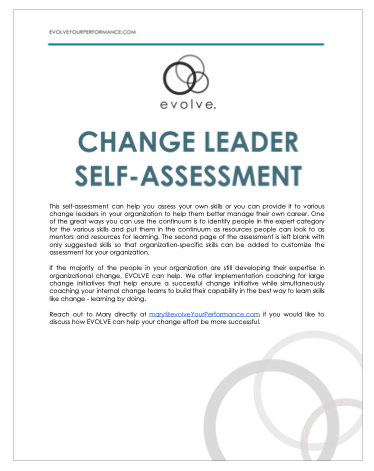-
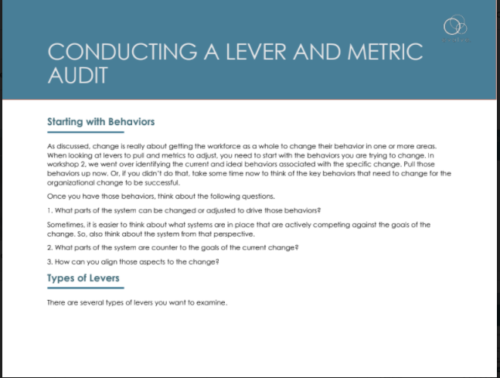 As discussed, change is really about getting the workforce as a whole to change their behavior in one or more areas. When looking at levers to pull and metrics to adjust, you need to start with the behaviors you are trying to change. In workshop 2, we went over identifying the current and ideal behaviors associated with the specific change. Pull those behaviors up now. Or, if you didn’t do that, take some time now to think of the key behaviors that need to change for the organizational change to be successful.
As discussed, change is really about getting the workforce as a whole to change their behavior in one or more areas. When looking at levers to pull and metrics to adjust, you need to start with the behaviors you are trying to change. In workshop 2, we went over identifying the current and ideal behaviors associated with the specific change. Pull those behaviors up now. Or, if you didn’t do that, take some time now to think of the key behaviors that need to change for the organizational change to be successful. -
 Change can be squishy. And yet, measuring change is a key success factor for any change for several reasons. Measuring success makes it easier to justify investment in proper change management in the first place. Also, measuring the progress of change makes it easier to evaluate and adjust various change interventions if they are not making the desired impact to the degree anticipated. Each change is different and the scorecard metrics need to be customized for the specific change being implemented. Some changes, like IT implementation, are easier than others, like a culture change. However, all change can be measured. The leadership spitball conversation is a good place to start for ideas on what success looks like for the leader(s). Then you can figure out how to quantitatively measures those factors for success. Below are some ideas for the four catergories included in the change scorecard.
Change can be squishy. And yet, measuring change is a key success factor for any change for several reasons. Measuring success makes it easier to justify investment in proper change management in the first place. Also, measuring the progress of change makes it easier to evaluate and adjust various change interventions if they are not making the desired impact to the degree anticipated. Each change is different and the scorecard metrics need to be customized for the specific change being implemented. Some changes, like IT implementation, are easier than others, like a culture change. However, all change can be measured. The leadership spitball conversation is a good place to start for ideas on what success looks like for the leader(s). Then you can figure out how to quantitatively measures those factors for success. Below are some ideas for the four catergories included in the change scorecard. -
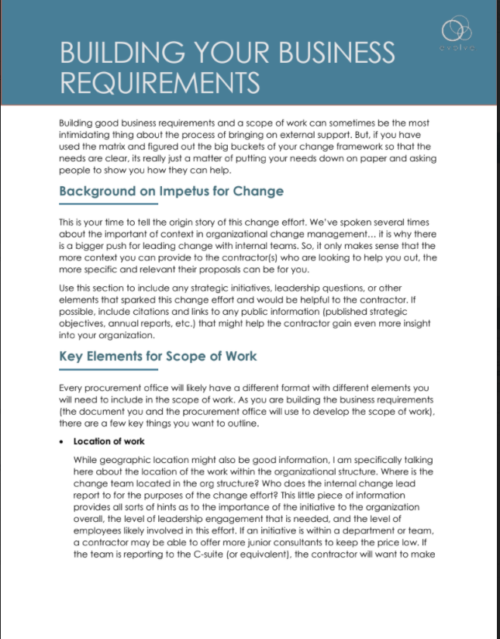 Building good business requirements and a scope of work can sometimes be the most intimidating thing about the process of bringing on external support. But, if you have used the matrix and figured out the big buckets of your change framework so that the needs are clear, its really just a matter of putting your needs down on paper and asking people to show you how they can help.
Building good business requirements and a scope of work can sometimes be the most intimidating thing about the process of bringing on external support. But, if you have used the matrix and figured out the big buckets of your change framework so that the needs are clear, its really just a matter of putting your needs down on paper and asking people to show you how they can help. -
 Building good business requirements and a scope of work can sometimes be the most intimidating thing about the process of bringing on external support. But, if you have used the matrix and figured out the big buckets of your change framework so that the needs are clear, its really just a matter of putting your needs down on paper and asking people to show you how they can help.
Building good business requirements and a scope of work can sometimes be the most intimidating thing about the process of bringing on external support. But, if you have used the matrix and figured out the big buckets of your change framework so that the needs are clear, its really just a matter of putting your needs down on paper and asking people to show you how they can help. -
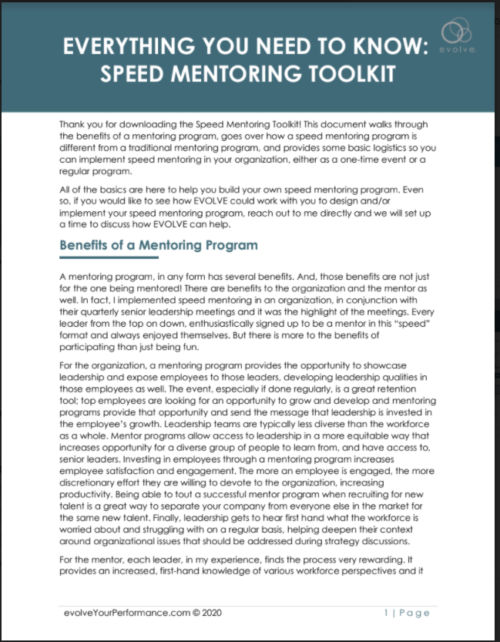 A mentoring program, in any form has several benefits. And, those benefits are not just for the one being mentored! There are benefits to the organization and the mentor as well. In fact, I implemented speed mentoring in an organization, in conjunction with their quarterly senior leadership meetings and it was the highlight of the meetings. Every leader from the top on down, enthusiastically signed up to be a mentor in this “speed” format and always enjoyed themselves. But there is more to the benefits of participating than just being fun.
A mentoring program, in any form has several benefits. And, those benefits are not just for the one being mentored! There are benefits to the organization and the mentor as well. In fact, I implemented speed mentoring in an organization, in conjunction with their quarterly senior leadership meetings and it was the highlight of the meetings. Every leader from the top on down, enthusiastically signed up to be a mentor in this “speed” format and always enjoyed themselves. But there is more to the benefits of participating than just being fun. -
 The concept of implementing organizational learning principles in an organization to help individuals and groups “learn to learn” (Schein, 2017), thereby making the ongoing adaptation and change that inevitably occurs in organizations more successful, is an interesting problem to explore. While interesting, there are very few studies that examine the sustainability of change in any context. Several theoretical models incorporate the idea of sustaining, or institutionalizing, change. But, very few empirical studies actually explore that concept.
The concept of implementing organizational learning principles in an organization to help individuals and groups “learn to learn” (Schein, 2017), thereby making the ongoing adaptation and change that inevitably occurs in organizations more successful, is an interesting problem to explore. While interesting, there are very few studies that examine the sustainability of change in any context. Several theoretical models incorporate the idea of sustaining, or institutionalizing, change. But, very few empirical studies actually explore that concept. -
 The SURF School Group Program is a six-week live program to give leaders and program managers all of the knowledge and tools they will need to implement the SURF Framework within your organization and achieve increased productivity. This is a guided course with support and coaching every step of the way.
The SURF School Group Program is a six-week live program to give leaders and program managers all of the knowledge and tools they will need to implement the SURF Framework within your organization and achieve increased productivity. This is a guided course with support and coaching every step of the way.
